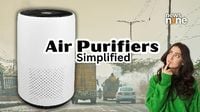As air pollution continues to plague cities like Delhi, where the Air Quality Index (AQI) recently soared past 400 at several monitoring stations, the humble air purifier has become a household staple—and not just for the health-obsessed. On November 12, 2025, Coway, South Korea’s leading wellness tech company, announced the launch of its Airmega 350 in Australia, a move that underscores the growing global demand for high-performance air cleaning solutions. But with so many models, specs, and marketing claims, how do you know which purifier is truly up to the challenge of today’s toxic urban air?
According to News9live, Delhi’s air is now considered not just polluted but toxic, with PM2.5 particles and volatile organic compounds (VOCs) seeping into homes and even the bloodstream. Dr. Rohit Caroli, a leading pulmonologist in Delhi, warns, “Delhi’s air has reached toxic levels, with PM2.5 and volatile organic compounds (VOCs) penetrating deep into the lungs and bloodstream. Such pollution doesn’t just irritate the throat or eyes, it silently accelerates asthma, COPD, heart disease, and even increases the risk of strokes and lung cancer.” This is no longer a seasonal inconvenience—it’s a public health crisis, and it’s happening indoors as much as out.
So, what should consumers look for in an air purifier? Across guides published by News9live and Smartprix, experts agree on a few non-negotiables: a powerful Clean Air Delivery Rate (CADR), a medical-grade True HEPA H13 or H14 filter, and a substantial activated carbon filter. The CADR, measured in cubic meters per hour (m³/h), indicates how quickly a purifier can clean the air in a given space. For small rooms (under 200 sq. ft.), a CADR around 150 m³/hr is recommended; for medium rooms (200–400 sq. ft.), 260–300 m³/hr; and for large halls, 300+ m³/hr. In high-pollution zones like Delhi, the purifier should clean the room’s air at least 3-4 times per hour.
“The ‘CADR’ is the only spec that matters for power,” Smartprix emphasizes. “Don’t just trust the ‘room size’ a brand advertises. Do look at the CADR. For a high-pollution zone like Delhi, you want a purifier that can ‘clean’ all the air in your room at least 3-4 times per hour.”
Filter quality is equally crucial. True HEPA H13 filters capture 99.97% of microscopic PM2.5 particles, while H14 filters go further, up to 99.995%. But that’s only half the battle: VOCs and harmful gases require a thick activated carbon filter. Thin, dusty “carbon-coated sheets,” as Smartprix puts it, simply won’t do the trick. The best models combine both, ensuring comprehensive protection against both particles and gases.
Noise and power consumption are practical considerations. Most good purifiers hum quietly at 25–50 decibels on low settings—comparable to a whisper—and consume 20–50 watts of electricity. For those who run their machines 24/7, this adds up to a modest ₹200–₹400 per month on the power bill, according to News9live.
Smart features like app control and voice support are increasingly common, but experts caution against prioritizing them over core functionality. “A solid HEPA + carbon combo, a reliable fan, and an accurate sensor are far more important,” News9live advises. Ionizers and UV-C lights may offer marginal benefits but can also produce ozone in some models, so choose those with proper certifications or the ability to turn them off.
Maintenance and cost of ownership are recurring themes. HEPA filters typically last 6–12 months, while carbon filters need replacing every 3–6 months. Filter replacements can cost anywhere from ₹2,000 to ₹9,000 depending on brand and model. “A powerful purifier is useless if its replacement filters cost ₹8,000 or are impossible to find,” Smartprix warns. Long-term filter life, such as Coway’s 8,500-hour filters, can be a game-changer for both convenience and cost.
The Airmega 350, Coway’s latest offering, is designed with these priorities in mind. Launched in Australia on November 12, 2025, the Airmega 350 boasts a sleek cylindrical design, cleaning spaces up to 182 square meters in just 60 minutes. It operates at a whisper-quiet 21.6 decibels, thanks to Coway’s HyperVortex™ filtration system, which includes three proprietary technologies: Eagle Vane Design for stable airflow, Vortex Generator Fan for enhanced circulation, and Dimple Duct Technology to reduce air resistance. Its 3-in-1 filtration system—a vacuumable pre-filter, activated carbon filter, and HEPA filter—removes 99.999% of ultra-fine particles as small as 0.01 microns and eliminates over 99% of VOCs, household odors, and fumes.
Additional features include a real-time Air Quality Indicator with a color-coded LED ring, Smart Auto & Sleep Modes that adjust fan speed and display brightness based on air quality and lighting, and an intuitive touchscreen control panel. Maintenance is made easy with an anti-dust grill and side-accessible filters. Available in beige and white, the Airmega 350 is designed to blend seamlessly into modern interiors. To celebrate its launch, Coway is offering a 30% discount from November 18 to December 1, 2025, during Black Friday & Cyber Monday promotions on Amazon Australia.
But how does the Airmega 350 stack up against other top models? Smartprix’s guide for Delhi-NCR’s toxic air highlights several heavy-hitters for large spaces: the SHARP FX-S120M-H (702 m³/h CADR, True HEPA H14 filter), Samsung AX7000 (773 m³/h CADR, dual fans), and Honeywell Air Touch U2 (650 m³/h CADR, 7-stage filtration including UV sterilization). For medium to large rooms, the Coway AirMega 250 and AirMega Storm are lauded for their smart sensors, robust build, and long filter life, while the AirMega 150 is praised for its quiet operation and low-maintenance design in smaller rooms.
Placement is another oft-overlooked factor. Purifiers should be kept at least 15 inches from walls and away from bathrooms or high-humidity areas. Elevating smaller units on a table can improve airflow. And while “auto mode” is convenient, experts recommend running purifiers on manual high settings during high-smog days, since built-in sensors may not detect pollution in every corner of a room.
Ultimately, there’s no one-size-fits-all solution. “The best machine is the one that’s right for your space and your budget,” Smartprix concludes. Trying to clean a large living room with a small, underpowered purifier is a waste of money. Be honest about your room size, invest in the CADR you need, and commit to regular filter replacement and maintenance. As Dr. Caroli underscores, “Choosing a purifier with a True HEPA H13/H14 filter for particles and a thick activated carbon filter for gases is one of the most effective, practical investments you can make for your family’s health.”
As air pollution becomes a year-round reality, the air purifier is no longer a luxury—it’s a necessity. With the right information and a bit of diligence, consumers can breathe a little easier, even when the world outside is anything but fresh.




